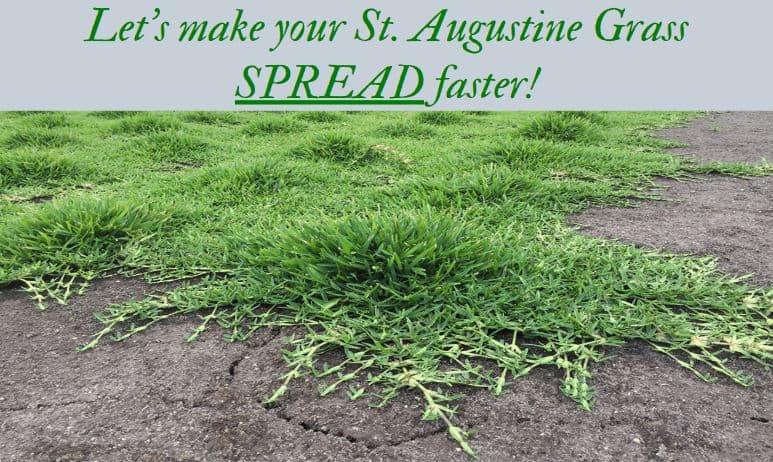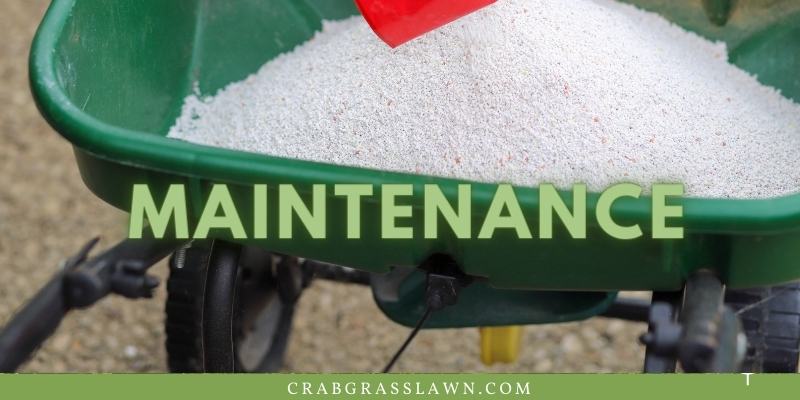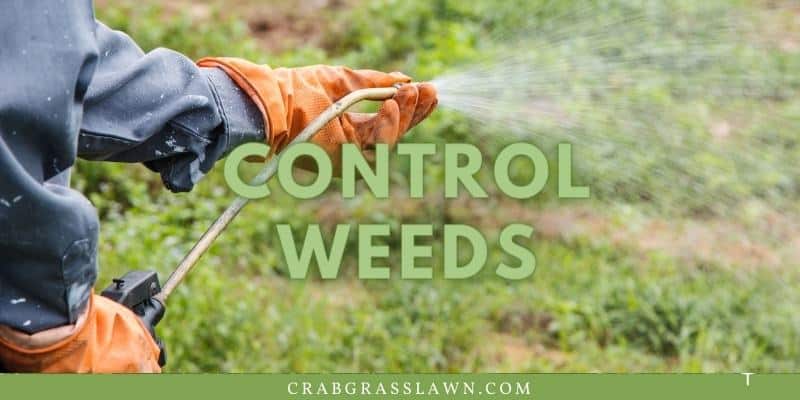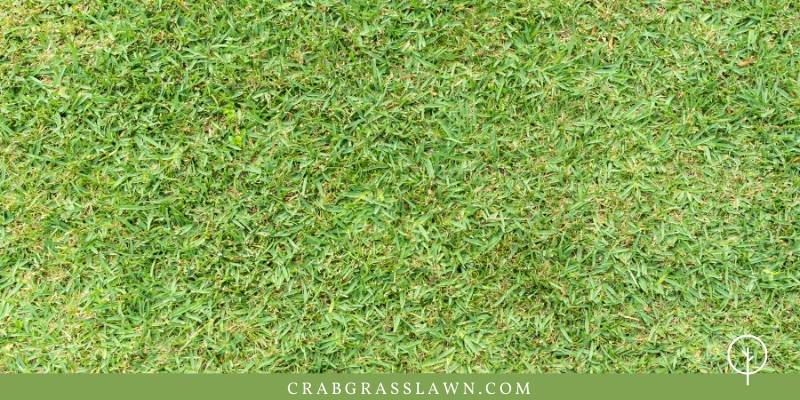St. Augustine grass has been one of my favorite residential turfgrasses for several years and reasons, starting with its rich green color and resilience. Many homeowners ask does St. Augustine grass spread and how to make it thicker.
Well, this robust turf variety spreads fast primarily through stolons and above-ground runners and there are several ways to enhance its thickness including applying a balanced fertilizer rich in nitrogen, phosphorus, and potassium and adhering to recommended mowing heights for lateral growth stimulation.
Key Takeaways
- St. Augustine grass spreads quickly due to above-ground shoots called stolons.
- Plant St. Augustine grass during summer.
- Consider a soil test and choose a well-draining soil with pH ranges from 5.0 to 8.5.
- Apply phosphorus fertilizer, and maintain a good watering and mowing schedule.
- Control weeds effectively to prevent competition with St. Augustine grass.
- High-density plug installation is the best method for faster St. Augustine grass spread.

Does St. Augustine Grass Spread?
Yes, St. Augustine grass has a dense growth pattern and spreads relatively fast in comparison to most types of warm-season turf grasses. This fast spread is facilitated by above-ground shoots (stolons). Learn about what grasses spread through rhizomes and stolons.
In addition, the fact that this grass species has good traffic tolerance means that it will still spread at a normal rate even when under use while it still hasn’t filled in.
I love the below product for St. Augustine lawns that I take care of. You can add this to most lawns and it will create the perfect growing condition and help your existing grass spread faster.
- Get Recommended ==> Simple Lawn Solutions Extreme Grass Growth Lawn Booster
How to Get St. Augustine Grass To Spread Quickly

Homeowners that don’t consider sodding as their preferred lawn method of establishing a lawn may have to wait for a bit longer before they have a filled-in, usable lawn. Read about sod to see if it may be a good option for your lawn.
However- you don’t always have to wait for so long because there’s always something you can do to make St. Augustine grass spread faster and grow thicker.
Here’s what you can do to help your St. Augustine lawn grow and spread faster to cover your entire lawn:
1. Use the right type of soil

Before planting St. Augustine grass on your lawn, you may want to choose a soil type that best supports the growth and spread of this turfgrass variety. Some soil types (such as waterlogged soil) tend to inhibit the growth of St. Augustine by depleting the underground oxygen supply.
For bare spots and uneven areas in your yard, you may need to add some topsoil, as this helps reduce pooling.
If your lawn is growing slowly and remains sparse or thin, the problem could be water-logging. This turfgrass does not grow and spread fast in compacted clay soils.
- The best soil for St. Augustine grass is one that is well-drained (like sandy soil) with pH ranges from 5.0 to 8.5. A slightly acidic pH will still be great for faster growth and spreading.
- For top-dressing a St. Augustine lawn, use either sandy loam soil or clean free-flowing sand. This is a product that I like to use in my St. Augustine repair jobs.
Affiliate links and images pulled from the Amazon Product Advertising API on: 2025-07-03
To find out whether you have the appropriate soil type to facilitate the fast growth of St. Augustine, you can reach out to A&M’s AgriLife soil testing service, They’ll test your soil and brief you on its health and quality. Or pick up a DIY soil test kit and find out what you need to do to your soil to give the perfect environment for your St. Augustine to spread.
2. Stick to the appropriate maintenance schedule

You should ensure to draft and follow a weekly lawn maintenance schedule post-establishment. Effective maintenance comprises watering, fertilization, and mowing. This will speed up the spread of St. Augustine grass.
The appropriate mowing height for St. Augustine grass is 3.5-4 inches. It’s also important to use a high-quality, slow-release fertilizer that will promote St. Augustine’s growth.
Phosphorus-laden fertilizers are great for stimulating grass spread during the first few months post-establishment. Afterward, you can switch to normal nitrogen fertilizer. The appropriate amount is about 0.7 lbs of “Nitrogen” per 1,000 sq ft. Be sure to read and follow the bag rate of your preferred fertilizer.
I recommend the Lesco 10-0-7 product as it contains a high amount of phosphorus for good root growth and establishment.
- Lesco Professional, 50 LB, 13,00 SQFT, 17-0-17 St Augustine Turf Fertilizer
- 30% Poly Coated Sulfur Coated Urea, Specially For St. Augustine Grass
- Should Be Applied When Turf Is Wet, Allow To Dry & Total Results In 2 Weeks, Safe For Floratam Variety, Slow Release Providing Up To 8 Weeks Of Feeding
Affiliate links and images pulled from the Amazon Product Advertising API on: 2025-07-02
Proper watering/irrigation is also important. It entails watering multiple times daily during the first week post-installation. For the second week, ensure to irrigate your St. Augustine grass sods/plugs up to at least half an inch of water.
By the sixth week, you should have scaled back the irrigation frequency to a point where you only water the lawn when necessary.
3. Plant St. Augustine grass during summer
Being a warm-season turfgrass, St. Augustine grows best during summer. You should, therefore, establish your lawn in mid-summer when conditions are great for the growth and spread of this grass species all over your lawn.
St. Augustine grass is usually dormant during the colder winter and fall seasons. Growing during these seasons is- thus- not recommended if you want a quick spread.
Get Recommended ==> Shop For St. Augustine Grasses Here and Have It Shipped Directly To Your Door
4. Control weeds effectively

You may also need to kill weeds in your St. Augustine grass early enough to prevent competition for nutrients and allow your lawn to grow thicker.
Unwanted weeds within your lawn will compete for important nutrients with your St. Augustine grass. Weed invasion can hinder the growth and spread of the desired plant species.
It’s crucial to effectively get rid of weeds in your lawn to make St. Augustine spread quickly and grow thicker. Common notorious grass weeds that can slow down the growth and spread of St. Augustine grass include crabgrass, dallisgrass, and most broadleaf weeds.
Look at our best Weed Killer for St. Augustine Grass here.
It’s important to note that you should not apply a herbicide if the temperature is over 85 degrees outside. Doing so can damage your grass.
Also see: How to Remove Crabgrass in Your Lawn Permanently
How Long Do St. Augustine Grass Plugs Take To Spread?
Normally, it takes about 7-14 days for newly installed St. Augustine grass plugs to begin spreading, following firm root establishment in the soil.

Once the rapid growth/spreading starts- however- the amount of time it will take for the bare spots on your lawn to be filled in may vary, depending on the plug spacing you choose.
Below, we take a look at the various plug installation spacing methods that will determine how quickly your St. Augustine grass plugs spread.
| Installation Method | Spacing Between Plugs | Fill-in Duration | Cost-Effectiveness |
|---|---|---|---|
| High-Density Plug | 6-11 inches | ~6-8 months | Less cost-effective |
| Typical Density Plug | 12-18 inches | ~8-10 months | More cost-effective |
| Low-Density Plug | 13-24 inches | Longer duration | Even more cost-effective, but better fitted for low foot traffic lawns |
High-Density Plug Installation
This method requires a 6-11-inch spacing between the sprigs, creating ample room for healthy root development. When the roots can tap adequate nutrients from the soil despite such close spacing, your chances of ending up with a fast fill-in are higher.
Typically, you should have a fully-filled, thick lush green lawn within 6-8 months if conditions are perfect.
Typical Density Plug Installation
This density choice requires St. Augustine grass plugs to be spaced out about 12-18 inches from each other. With this density, the St. Augustine grass plugs will spread at a slower rate and you’ll have to endure a longer fill-in duration for bare spots on your lawn.
On the upside, it’s more cost-effective compared to high-density plug installation, as you won’t have to use lots of sprigs to cover up your entire lawn. Expect to wait ~8-10 months for it to fill in.
Low-Density Plug Installation
This option requires a 13-24 inch spacing- and is recommended for lawns that experience low foot traffic since it takes time for the St. Augustine plugs to fully spread out over the entire lawn with such wide spacing.
Typically, it takes well over a year for St. Augustine grass to spread and fill in over a regular-sized backyard lawn.
Can You Buy St. Augustine Grass Seed?

Short answer, no. Unless you are planning on starting a sod farm. You don’t need to seed a yard with St. Augustine. This grass type comes in plugs or cuts of squares on pallets and this is what you will plant in your yards. Using plugs is much cheaper upfront but requires a few weeks of patience while it fills in.
I have never purchased St. Augustine grass seed before and don’t suggest looking for it, you’ll just be spinning your wheels.
I leave that to the sod farms and just buy plugs if I need to fill in a spot in a St. Augustine yard. If my local sod farm is backed up or doesn’t have the variety I’m looking for I’ll go with SodSolutions, which has access to many different Augustine varieties and they will ship it directly to your door. I’ve never had any issues with getting sod shipped to me and the quality is excellent.
Shop for St. Augustine Grass at SodSolutions and have it sent directly to your door.
For more options, check out my article on where to buy St. Augustine grass seed.
Best Topsoil for St Augustine Grass
When shopping for the best topsoil for St. Augustine grass, you’ll be spoilt for choice given the myriad options available. But the best topsoil for St. Augustine grass is one that is well-draining like sandy soil and one that has a pH range between 5.0 to 8.5.
Remember St. Augustine grass requires an appropriate amount of oxygen supply for good growth and development and will not thrive in compacted clay soil due to the lack of oxygen.
You can feed alfalfa to improve sandy soil or add Milorganite, soybean meal, or cottonseed meal if alfalfa isn’t available.
Wonder Soil Premium Nutrient-Rich Lawn Top Dressing
Affiliate links and images pulled from the Amazon Product Advertising API on: 2025-07-02
The Wonder Soil topsoil is a nutrient-rich product that provides nutrients as well as increases water retention to help St. Augustine grass thrive and grow.
It is a blend of worm castings, kelp, gypsum, magnesium, and much more. The Wonder Soil topsoil can be used by novice and seasoned gardeners and enhances moisture in light soils and loosens heavy clay soils.
FAQs
Will St Augustine Grass Fill In Bare Spots?
St. Augustine can fill in bare spots in your lawn only if you use sod or plugs. You can buy a few pieces of sod or the right amount of plugs to cover the bare spots from your local garden center.
How to Get St Augustine Grass to Grow in Bare Spots?
Once you have enough plugs or sod to cover the bare spots, prepare the area by applying a generous layer of starter fertilizer, which will provide a good base for the new sod or plugs and improves overall moisture retention.
Lay the pieces of sod or plugs directly on the soil and secure them with your feet and lastly water thoroughly.
How to Prepare Soil for St Augustine Grass?
Start by removing any weeds, rocks, and debris from the area. Avoid adding any pre-emergence herbicides as they may harm the sod or plugs.
If you have compacted soil, use a rototiller to loosen it up and then evenly add some organic matter to the top four inches of the soil if needed. Lay and roll out the new sod or plant the grass plugs.
When Does St Augustine Grass Come Out of Dormancy?
St. Augustine grass may remain green all year round and never enter dormancy. But if the grass does grow dormant, the dormancy period usually lasts until temperatures rise above 55℉ (12℃). The dormancy period of St. Augustine grass can last a while, sometimes even months, depending on your local weather.
In a nutshell…
Just to recap what’s been discussed – St. Augustine grass is a fast-spreading turfgrass species. However, you can still improve this spread-rate by considering a few aspects. But always start with a soil test so you know how to treat your yard properly for optimal growth.
The rate at which St. Augustine grass spreads depends on various factors including- soil type, lawn maintenance routine, and the time of planting/installation.
Related Articles
How to Paint a Lawn?
Hi, Alex Kuritz here. Growing up I remember that my family had one of the best lawns in the neighborhood. Richly green and lush. I did a lot as I grew up in terms of caring and tending for not only my family’s lawn but also my neighbors. I can say I have years of experience, and I am here to share it with you.






Hi saw your video I have st. Augustine sod for about 3 weeks.
Wondering when and which brand I should get for fertilizer?
Also, can I add grass seed to the more barren areas? If so, which type do you recommend…is St. Augustine grass seed available?
It’s doing ok living in Florida it’s really the only grass that does well although I prefer the softer grass.
For now, I light-water 2 times per week
Thanks in advance for taking the time to answer my questions.
Sincerely
Judy Kirshner
Just, try Sunniland out of Sanford. Most Lowe’s carry their products. I suggest the white bags labeled Sunnlind Professional. Don’t let the label detour you off as it’s specifically tailored for Florida climate. Go to sunnilands website they have all their products broken down.
They come in plugs only where I come from here in So CA, San Bernardino Area. I never seen seeds???
No seeds available for st.augustine. only sod and plugs.
Hello. I have an area of roughly 500 sq ft where the St. Augustine runners are dry and visible.
Can I lay topsoil over that area to encourage the healthy st. Augustine to spread where the runners have dried?
Thanks in advance for your advice
Yes, sure. And enough watering as well.
Trying to put the right soil down to add on St. Aug grass has been difficult to say the least. Most stores carry this composite stuff (not real dirt) and I have spread it over my lawn which is not responding to running. How do I remove and add real dirt? Any suggestions on which brands to purchase at Lowe’s or Homedepot?
Sod layed in January. Established well but due to overwatering, got fungus. I applied Immunox PlusI noticed that the blades are thin, it’s a thin lawn but evenly thin except for the fungus. Can you tell me what to throw down on it to get, like you said, for it to get bigger blades, thick and spreading? I was using cornmeal but didn’t do much. Literally, can you tell me the brand and ratio to get or a link? I only have 150 square foot townhome but other neighbors it’s dark green (nitrogen?) and thick like a carpet and erect and their sod was layed down same as mine. Fungus just in a few spots but I treated the entire lawn. What’s next?? Thanks you!!!!
Jeff Messing, check out YouTube channel for Lawn Care Nut Allyn Hane. He discusses using 2 different types of fungicides at same time to battle lawn problems with better results than just using one type. There is a code on product labels and he says to look for type 3 and type 11. His channel is a treasure trove of all kinds of advice.
I have some areas that are very dense some bare spots in other areas. What size plugs should i dig up to plug the bare areas?
If you do around 2-3″ plugs you should be good to fill in those bare spots. I’ve done that plenty of times for neighbors.
I have weeds galore in my front yard, and in my back it’s mostly dirt with weed and some grass. My side has a good healthy amount of st Augustine. Where should I start? Should I just plant now and kill weeds after or kill weeds now and then plant?
Hey Sean, thanks for writing in. I would give it a good dose of Tenacity to take care of the weeds first and the lay down new sod. If you want sod delivered straight to you, take a look at SodSolutions here https://www.crabgrasslawn.com/sodsolutionssod I’ve been workin’ with these guys lately and impressed on their sod selections, price, and how they get it delivered to you.
I recently Soded my lawn with St. Augustine grass fur having several tree and yard being very shaded. The laen is doing well but I want to fertilize for the fall. What fertilizer do you recommend to thicken and green my lawn.
I posted a comment in seeking help for dry looking brown runners after the blog on organic fertilizers for St Augustine grass. I appreciated any suggestions you might have. I spread peat moss over the area.. I was told it was probably root rot or maybe too much water! We live in central Florida and have sandy well drained soil.
Too much water will certainly lead to root rot. Do you have any pics you can upload?
Good evening and “Hi” I just planted Saint Augustine plugs in my front yard today 10/23/2020 spaced them atleast 12 – 13 inches apart, I cleaned up the soil from old grass and weeds as much as I could. ( I turned the soil over and then cleaned it from weeds an old grass) I leveled the area out and started to plant the plugs they said to water first?? I didnt??? After I planted all the plugs I spreaded out TOPPER the soil in the bag for new lawns and after I watered throughly. Since its early fall will the plugs spread slower rather in the early summer?? Anyways I’m finished it !!! Whats next? Just wait for the plugs to spread? If I see weeds meaning new shoots growing I’m gonna snatch them out also to inform you prior to doing all this planting I also sprayed on the soil surface weed killer last Tuesday 10/20 and Bug killer 10/22 then today I planted the plugs. Will these two sprays ruin my chances for the plugs to spread or will it take no effect on the plugs??? And the plugs die due to the 2 sprays I just sprayed on the dirt a few days ago this week? I watered today twice after I planted an then I watered again this evening.
What part of the country are you in? Typically in the fall wherever you are will slow the spread of any grass. St. Augustine should still spread but not like it will over the summer months. Just keep a regular watering cycle and nab any weeds that pop up in the bare spots. By spring it should be filled in. Leave some pics if you want.
Why does this article say a year to fill in? Job done in 3 months with plugs of sprigs.
Could be up to a year depending on the area to fill. Using more plugs is ideal for faster fill-in.
Hi. I plugged with St Augustine in some spots about 2 yrs ago. It filled in nice. But it seems like I never need to cut it. And reasons why that might be?
Almost sounds like a good problem if it looks good. 🙂 Do you know the variety you put in?
Question 2. Any way to get rid of Bermuda grass in my St Augustine lawn?
How thick is it? That can be tricky, but pulling it by hand down to the root should do the trick if it’s not too thick. Then the St. Augustine ‘should’ take over.
Hello, my central Florida back yard was full of weeds with some St Augustine scattered around the yard. I killed the weeds with Celsius, which worked slowly, but completely. I would like to care for the existing St Aug. so I don’t have to buy plugs or sod? Am I dreaming? Would like some thoughts, thanks.
Well depends on how quickly you want it to fill in. 🙂 Plugs are always helpful for faster coverage.
Hello ,
Am struggling with the St. Augustine grass. I live in Priddy ,Tx which is kinda southwest of I35.We have black mix keleech rock . this country is good for grazing sheep an goats. Am grass looks brown worn spotty bare places. Last year it looked good. Fertilizes ,weedkiller all but soil tested. This winter its awfully dry. So do I water it durning the winter if its above freezing
You can water over the winter but try to keep it around 1″ per week.
I live in Florida and my yard is very sandy. Do you think this would work in it? I feel like when I mow, I’m mowing weeds in a sand dune, not grass in a yard.
Do you happen to have a pic of the area?
Neighbor next door has Tiff419 which is slowly trying to invade my St. Augustine. I tilled prior to installing new yard as well as sprayed with grass/weed killer to try and help prevent this from happening. I also put metal landscape barrier to separate yards. Unfortunately, as invasive as Bermuda is, I’m starting to see it show up in my yard. Any suggestions on how I can choke it out? Appreciate any advice you might have.
Hi Greg, check out this post I did on how to kill Bermuda grass in a lawn: https://www.crabgrasslawn.com/how-to-kill-bermuda-grass-get-rid-in-lawn/
I planted st.augustine plugs with weeds in my yard and it filled in nice no problems.
Ijust keep it watered and it took off,i had to do nothing else it easy.
Can I send a picture of grass/weed.Not sure of problem.
Yes please do so in our Facebook Group here
https://www.facebook.com/groups/866415330515149